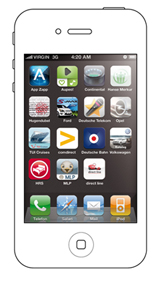Thanks to the ubiquity of smartphones and tablets, mobile advertisers have entered a golden age of opportunity. According to the Internet Advertising Bureau (IAB), the UK mobile advertising market was worth £83m in 2010, up from £37.6m the previous year. Consulting agency FirstPartner estimates that the UK market will reach a total value of £992m by 2015.
This is great news for marketers, but are businesses harnessing the full potential of mobile advertising? According to research compiled by Deloitte this year, the answer is no. The report states that 88% of UK consumers ignore ads on their mobiles and 36% automatically delete them, while just 9% take any further action after viewing a mobile ad.
These stats probably do not come as much of a surprise to those in the industry. Part of the problem is the age-old dilemma that ad execs have always encountered when promoting a brand. Consumers see most adverts as an interruption to the actual experience they want to have.
Free Apps
Unsurprisingly, companies are trying to find ways to encourage smartphone and tablet users to respond to mobile adverts – with many opting to send out ad-supported free apps. This is feasible, now that the current advertising-funded model is more sustainable and is generating higher revenues through the all-important CTRs (click through rates). This enables them to switch from a paid-for application model to the free-to-the-end-consumer ad-funded application model.
But this “freebie” app approach does not always lead to a win-win scenario, especially when you consider the fierce competition in app stores. There are now more than 500,000 iPhone apps, as well as over 150,000 apps for Android available, many of which are already free.
In addition, with so many choices, consumers may be unaware of which app is right for them or whether the app they want even exists. How does the developer help marketers deliver the right product to the consumer and get it noticed?
Making a Good App
When creating applications, developers need to provide a unique, value-added product to the consumer. The app must also be constantly updated or users will gradually stop using the app. The last point is important to stress, as developers often underestimate the work required to upgrade apps. End consumers expect up-to-date applications and want them delivered quickly. The developer must create an app that can be easily upgraded, or they risk losing users or receiving bad app store reviews.
In addition, many marketers are looking to innovative and different approaches to advertising, such as through location-based apps that ultimately reward the user, or ‘freemium’ games that take longer to progress for free users, but allow upgrades at a cost.
Future of Application Delivery – app stores
The best way to do this is by giving apps an edge over the thousands of competitors. There are several tools available that assist developers to leverage their apps into the Top 25 lists for free apps on the Apple App store.
Two thirds of all smartphone owners currently rely on official app store charts to keep up to date with the latest and hottest apps, and the average user downloads at least one ranked app per week. That’s why app store rankings, for all platforms, are vital to the visibility and popularity of an app. It’s similar to the way search engine results are prioritised on Google.
Once an app is in the top 25, the visibility of an app is significantly increased, leading to many downloads, and ultimately more usage. If an app does not make the grade, then users can only find it via the search box or a direct link, and this can greatly affect the success of an app.
More Distribution Channels
The landscape of the app store and how applications are distributed continues to change each day, and there are a number of companies that are already trying to cut out app stores and designing web-apps. This is an important fact to stress, as often, an application is only focused and developed for one app store – which can impact success. Web-apps are accessible through multiple OS platforms and do not require the user to download anything.
Therefore, developers need to distribute their apps on the most popular app stores and in web-app format to ensure all smartphone users have access to the app.
In addition to keeping up with the app store charts, developers should also use viral marketing across multiple social media channels to get their app noticed. Provided that their app is well-designed, this method of promotion is an effective and efficient way to target the right kind of audience. The same goes for the way ads are placed in apps – they need to be targeting the right audience.






